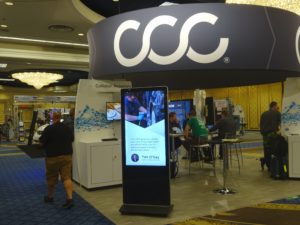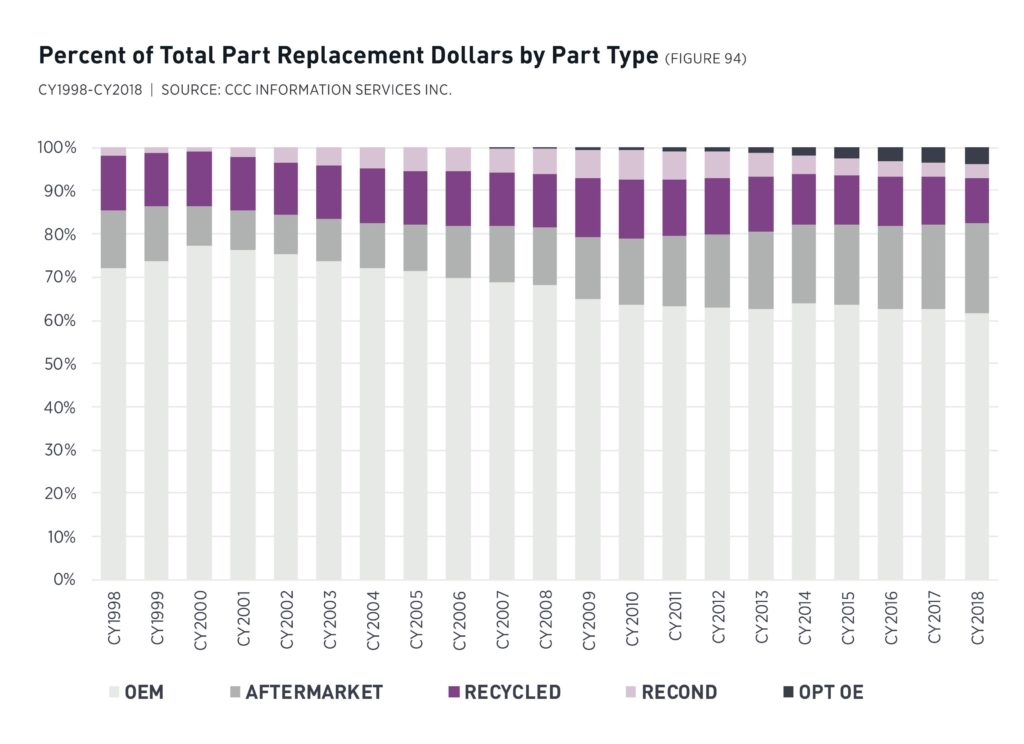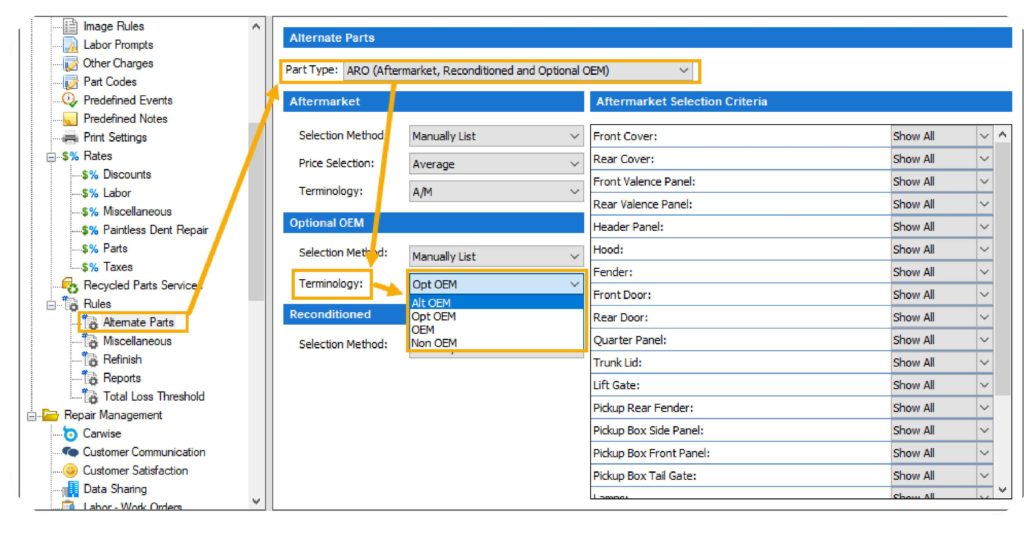
CCC issues list of parts definitions for suppliers, offers shops choice of what to call ‘Optional OEM’
By onAnnouncements | Business Practices | Education | Market Trends | Repair Operations | Technology
CCC has taken a stand on what to call “Opt-OE” and other categories of components, issuing six parts definitions and binding suppliers to adhere to them.
CCC Vice President of Market Solutions Mark Fincher said the company has updated its pacts with parts vendors.
“They have agreed to use these new definitions,” he said. It’s a contractual agreement, he said.
CCC obviously won’t be physically inspecting parts to police this, Fincher said. But he reiterated the contractual nature of the agreement and said repairers who catch a supplier violating those terms and definitions can report it to CCC. (Contact your account rep or technical support, Fincher said.)
CCC felt it had taken sufficient steps and “suppliers are all looking to do the right thing,” he said.
The categories are:
OEM: “OEM parts are manufactured by or for the vehicle’s Original Equipment Manufacturer (OEM) according to OEM’s specifications for U.S. distribution. OEM parts are available at OE/Vehicle dealerships or the specified supplier.”
Optional OEM: “New OEM part manufactured by or for the OEM according to the OEM’s specifications for U.S. distribution and available from the vendor specified on the estimate at vendor’s discounted list price. Parts are delivered to repair shop in the original OEM manufacturer packaging and/or labeling.”
Aftermarket: “New part offered as an alternative to the OEM replacement part including but not limited to: New part not manufactured by or for the OEM; new part not manufactured for OEM but produced by same manufacturer that also produces OEM parts; or new part manufactured by or for the OEM for distribution outside of the United States.”
Reconditioned: “Reconditioned OEM part.”
Remanufactured: “Remanufactured OEM part.”
Recycled: “Used OEM part.”
The definitions have been appearing on estimates for the consumer to see as well, Fincher said.
“For nearly a year, CCC has been with engaging suppliers, insurers, and repairers, discussing part-type descriptions, OPT OEM labels, and how this information may be presented on printed estimates,” the company wrote in a communique. “The conversations have proven extremely helpful in understanding the unique perspectives of each group and in building understanding around the issues and opportunities related to OPT OE parts.”
It said it “(w)orked with suppliers, insurers, and repairers, aligning around definitions for alternative part-types” and adjusted CCC ONE, “offering users the ability to configure how they want Optional OEM parts displayed on estimates.”
CCC on Wednesday went live with the latter for shops; insurers have been phasing it in over the past “month or so,” Fincher said.
Shops and insurers may now reclassify those “Optional OEM” parts into one of four categories on the actual estimate. These include the “OEM” and “Non OEM” terms California accepts and the “Opt OEM” and “Alt OEM” terms it doesn’t. The latter two categories had been selectable before, Fincher said.
We asked why CCC bothered to include “ALT OEM” at all as it seemed to preserve confusion and was discussed nowhere else in CCC’s memorandum.
“I don’t think that’s used very often,” Fincher said of the term. He wasn’t sure the origins of “ALT OEM,” but speculated someone requested it at some point. So “we’re gonna leave that in there” for those who do use it, he said.
CCC also said blemished parts shouldn’t be sold under any of the company’s formal parts categories, “as this would create uncertainty around what the specified part for repair.”
The company also was adamant that “Other Product Lines produced by a vehicle OEM’s Tier One Manufacturer (Hella, Bosch, Magneti, etc.)” and “Remanufactured, Reconditioned, or Used Parts” are not “Optional OEM.” More on all that here.
California
Automotive repairers in California, arguably the nation’s most important market, are governed by Business and Professions Code 9884.9, which says they must identify parts as “new, used, rebuilt, or reconditioned.” They must also comply with 16 California Code of Regulations §3353: “Each new replacement crash part listed in the estimate shall be an original equipment manufacturer (OEM) part unless specifically identified as a non-OEM aftermarket crash part.”
The BAR had seen a trend of parts being labeled with nebulous terms along the lines of “Opt-OEM” and a BAR official said in September 2018 such a label “does not meet the requirement” of telling customers what kind of parts are actually being installed.
Using vague terms like “Opt-OEM” would also be an unfair claims settlement practice, California Department of Insurance general counsel and Deputy Commissioner Kenneth Schnoll wrote in October 2018 to the California Autobody Association. The trade group had sought a legal opinion on the behavior.
“Accordingly, because insurers are required to follow the same standards as auto body collision repair shops in connection with repair estimates, insurers are also prohibited from using any description of any replacement part other than new, used, reconditioned, rebuilt, an OEM crash part, or a non~OEM aftermarket crash part,” Schnoll wrote.
In January, the BAR muddied the waters by recognizing an OEM part sold by a third party and unwarranted by the automaker as “OEM.” It was slated to take up the warranty question again in October, but Mark Guess of the BAR said during that meeting that the matter had been tabled.
Adjusting definitions
The status quo in California arguably requires the option to classify such an “Optional OEM” part further as OEM or non-OEM. Love or hate the decision that a part sold and warrantied outside of the authorized channel can be called OEM, that’s the rule everyone’s got to live with in California until the BAR figures out what it wants to do.
But we asked Fincher if he was concerned about “definition creep” from the other 49 states’ repairers and insurers representing what CCC itself feels to be “Optional OEM” as OEM to the end consumer.
He noted that based on CCC’s definition, an “Optional OEM” part was still a new OEM part and “meets the same definition as an OEM part” except it was provided as a discounted list price.
We asked then if only dealerships would be using the “Optional OEM” term, because a third-party vendor would open up the contentious issue of the part’s warranty.
CCC looked at the warranty issue, Fincher said. But it wasn’t addressed in California’s language either, and “we’ve left the warranty piece out of that definition,” he said.
He said CCC’s concern was making a definition so specific that it conflicted with what various individual states required.
“We’ll continue to follow that,” he said of the warranty issue.
Therefore, it sounds as though it will be incumbent on repairers and insurers in the rest of the country not to reclassify what CCC thinks are “Optional OEM” parts as OEM and potentially mislead consumers.
However, it’s also notable that shops and carriers have the option to go the other way as well and represent an “Optional OEM” part as “non OEM.” This would allow shops and insurers to follow the path promoted by a CIC Parts subcommittee led by SCRS Executive Director Aaron Schulenburg: Call any new part not sold in the OEM’s authorized supply chain and warrantied by the OEM “non-OEM” first and foremost, and then explain it further to the consumer after that.
The other committee, led by SSF Imported Auto Parts business development director Ken Weiss, has proposed eliminating “Optional OEM” and dividing new parts into six part categories. Those are broadly classified along the lines of OEM, Tier 1-built parts identical to the OEM’s, and aftermarket.
CCC provided us with a handy job aid repairers and insurers can use to pick what they want “Optional OEM” parts to appear as.
If you do nothing, the field defaults to Opt-OEM. To select one of the other three options, edit your claim office or body shop profile, and select Estimating >> Rules >> Alternate Parts. From there, select the “ARO” option and pick the term you want in the Terminology section.
Gray market
CCC’s official definitions show the company views gray market parts — parts produced for another country and imported into the U.S. — as aftermarket. However, it will still allow such parts to be categorized as “Optional OEM,” but it wants distributors to clarify them with the term “GRYMKT.”
“Gray Market OEM parts are manufactured according to specifications provided by the original vehicle manufacturer that have been purchased from a foreign source that purchased the part from foreign OE authorized dealers and/or their subsidiaries,” CCC wrote. “Certain OEMs do not recognize these parts as OEM parts as they are outside of their supply chains, recall processes, and warranties. Gray Market OEM parts may be categorized as Optional OEM (OD) based on the current CA BAR definitions. These parts should carry a distributor designation of “GRYMKT” which enables shops and insurers to decide when this type of part is an acceptable alternative. CCC users may elect to add a line note regarding foreign sourcing and warranty when using these parts for consumer transparency. CCC ONE may also be enhanced in the future to automatically add the line note when Gray Market OEM part is specified. Changes to regulatory definitions, including a CA BAR proposal currently under consideration, could result in changes to how gray market parts are categorized.” (Emphasis CCC’s.)
Fincher said some automakers don’t recognize gray market parts at all, and so CCC wanted those parts identified so shops and insurers could make an informed decision.
“We’re looking at how to implement that,” Fincher said of the gray market identifier. The company hasn’t yet finalized its strategy for identifying such parts, he said.
“That’ll be completed shortly,” he said.
As noted above, CCC’s official definition calls gray market parts “aftermarket.” We asked if suppliers were required to use that categorization in the other 49 states or if CCC’s code just automatically converted such components to aftermarket in other venues.
Fincher said suppliers could still call gray market parts “Optional OEM” but must use the gray market designator. If the supplier called a part aftermarket, they wouldn’t use that term.
More information:
How to configure what you want ‘Optional OEM’ parts to be called on CCC estimates
CCC, Nov. 25, 2019
“Parts & Material Committee Update” slides
Collision Industry Conference, Nov. 5, 2019
Images:
The CCC booth at SEMA 2019 is shown. (John Huetter/Repairer Driven News)
CCC data shows “Opt-OE” parts growing as a proportion of part spending over the past decade. The company has issued a definition for what it calls “Optional OEM” and allows repairers and insurers to call such parts “Opt OEM,” “Alt OEM,” “OEM” or “Non OEM” on estimates. (Provided by CCC)
CCC on Wednesday went live with an option for shops to choose how they want “Optional OEM” parts displayed on estimates: These include the “OEM” and “Non OEM” terms California accepts and the “Opt OEM” and “Alt OEM” terms it doesn’t. The latter two categories had been the only options prior to the new Version 6.4. (Provided by CCC)
A tug and cargo ship are seen in the Port of Long Beach, Calif. (halbergman/iStock)



